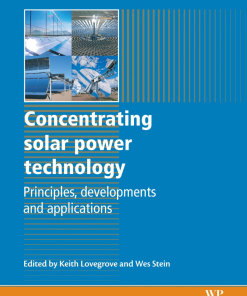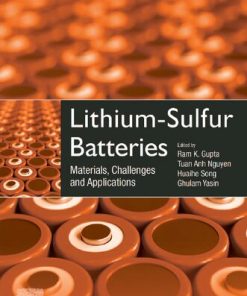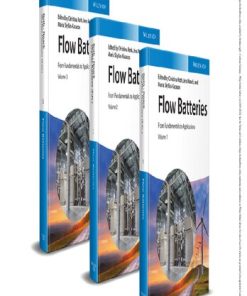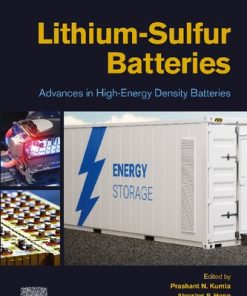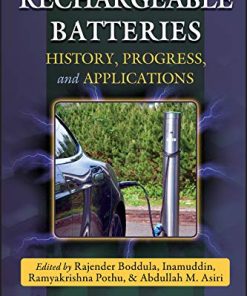(Ebook PDF) Zinc Batteries Basics Developments and Applications 1st edition by Rajender Boddula, Inamuddin, Abdullah Asiri 1119662389 9781119662389 full chapters
$50.00 Original price was: $50.00.$25.00Current price is: $25.00.
Zinc Batteries: Basics, Developments, and Applications 1st edition by Rajender Boddula, Inamuddin, Abdullah M. Asiri – Ebook PDF Instant Download/DeliveryISBN: 1119662389, 9781119662389
Full download Zinc Batteries: Basics, Developments, and Applications 1st edition after payment.
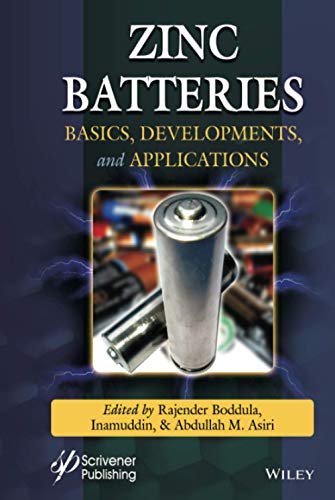
Product details:
ISBN-10 : 1119662389
ISBN-13 : 9781119662389
Author: Rajender Boddula, Inamuddin, Abdullah M. Asiri
Battery technology is constantly changing, and the concepts and applications of these changes are rapidly becoming increasingly more important as more and more industries and individuals continue to make “greener” choices in their energy sources. As global dependence on fossil fuels slowly wanes, there is a heavier and heavier importance placed on cleaner power sources and methods for storing and transporting that power. Battery technology is a huge part of this global energy revolution. Zinc batteries are an advantageous choice over lithium-based batteries, which have dominated the market for years in multiple areas, most specifically in electric vehicles and other battery-powered devices. Zinc is the fourth most abundant metal in the world, which is influential in its lower cost, making it a very attractive material for use in batteries. Zinc-based batteries have been around since the 1930s, but only now are they taking center stage in the energy, automotive, and other industries. Zinc Batteries: Basics, Developments, and Applicationsis intended as a discussion of the different zinc batteries for energy storage applications. It also provides an in-depth description of various energy storage materials for Zinc (Zn) batteries. This book is an invaluable reference guide for electrochemists, chemical engineers, students, faculty, and R&D professionals in energy storage science, material science, and renewable energy.
Zinc Batteries: Basics, Developments, and Applications 1st Table of contents:
1 Carbon Nanomaterials for Zn-Ion Batteries
1.1 Introduction
1.2 Co4N (CN) – Carbon Fibers Network (CFN) – Carbon Cloth (CC)
1.3 N-Doping of Carbon Nanofibers
1.4 NiCo2S4 on Nitrogen-Doped Carbon Nanotubes
1.5 3D Phosphorous and Sulfur Co-Doped C3N4 Sponge With C Nanocrystal
1.6 2D Carbon Nanosheets
1.7 N-Doped Graphene Oxide With NiCo2O4
1.8 Conclusions
Acknowledgements
References
2 Construction, Working, and Applications of Different Zn-Based Batteries
2.1 Introduction
2.2 History
2.3 Types of Batteries
2.4 Zinc-Carbon Batteries
2.5 Zinc-Cerium Batteries
2.6 Zinc-Bromine Flow Batteries
References
3 Nickel and Cobalt Materials for Zn Batteries
3.1 Introduction
3.2 Zinc Batteries
3.3 Nickel-Zinc Battery
3.4 Advantages
3.5 Challenges
3.6 Effect of Metallic Additives, Cobalt and Zinc, on Nickel Electrode
3.7 Conclusion
References
4 Manganese-Based Materials for Zn Batteries
4.1 Introduction
4.2 History of the Zinc and Zinc Batteries
4.3 Characteristics of Batteries
4.4 MN-Based Zn Batteries
4.5 Conclusion
References
5 Electrolytes for Zn-Ion Batteries
5.1 Introduction
5.2 Electrolytes for Rechargeable Zinc Ion Batteries (RZIBs)
5.3 Summary
Abbreviation Table
Acknowledgments
References
6 Anode Materials for Zinc-Ion Batteries
6.1 Introduction
6.2 Storage Mechanism
6.3 Zinc-Ion Battery Anodes
6.4 Future Prospects
6.5 Conclusion
References
7 Cathode Materials for Zinc-Air Batteries
7.1 Introduction
7.2 Zinc Cathode Structure
7.3 Non-Valuable Materials for Cathode Electrocatalytic
7.4 Electrochemical Specifications of Activated Carbon as a Cathode
7.5 Extremely Durable and Inexpensive Cathode Air Catalyst
7.6 Hierarchical Co3O4 Nano-Micro Array With Superior Working Characteristics Using Cathode Ray on Pliable and Rechargeable Battery
7.7 Dual Function Oxygen Catalyst Upon Active Iron-Based Zn-Air Rechargeable Batteries
7.8 Conclusion
Nomenclature
References
8 Anode Materials for Zinc-Air Batteries
8.1 Introduction
8.2 Zinc Anodes
8.3 Conclusions
References
9 Safety and Environmental Impacts of Zn Batteries
9.1 Introduction
9.2 Working Principle of Zinc-Based Batteries
9.3 Batteries: Environment Impact, Solution, and Safety
9.4 Conclusion
Acknowledgement
References
10 Basics and Developments of Zinc-Air Batteries
10.1 Introduction
10.2 Zinc-Air Electrode Chemical Reaction
10.3 Zinc/Air Battery Construction
10.4 Primary Zn/Air Batteries
10.5 Principles of Configuration and Operation
10.6 Developments in Electrical Fuel Zn/Air Batteries
10.7 Conclusion
References
11 History and Development of Zinc Batteries
11.1 Introduction
11.2 Basic Concept
11.3 Cell Operation
11.4 History
11.5 Different Types of Zinc Batteries
11.6 Future Perspectives
11.7 Conclusion
Abbreviations
Acknowledgement
References
12 Electrolytes for Zinc-Air Batteries
12.1 Introduction
12.2 Aqueous Electrolytes
12.3 Electrolytes of Non-Aqueous
12.4 Summary
References
13 Security, Storage, Handling, Influences and Disposal/Recycling of Zinc Batteries
13.1 Introduction
13.2 Security of Zinc Battery
13.3 Influence of Zinc Battery
13.4 Disposal/Recycling Options
Acknowledgement
References
14 Materials for Ni-Zn Batteries
14.1 Introduction
14.2 Expansion of Ni-Zn Battery
14.3 Application
14.4 Conclusion
People also search for Zinc Batteries: Basics, Developments, and Applications 1st:
zinc used in batteries
zinc based batteries
zinc battery technology
zinc batteries vs lithium
zinc batteries
Tags:
Zinc Batteries,Basics,Developments,Applications,Rajender Boddula,Inamuddin,Abdullah Asiri
You may also like…
Uncategorized
Engineering - Industrial Engineering & Materials Science
Lithium-Sulfur Batteries: Materials, Challengess and Applications 1st Edition Gupta R.K.
Uncategorized
Engineering
Lithium-Sulfur Batteries: Advances in High-Energy Density Batteries 1st Edition Prashant Kumta
Engineering - Energy & Power Resources
Rechargeable Batteries: History, Progress, and Applications 1st Edition



